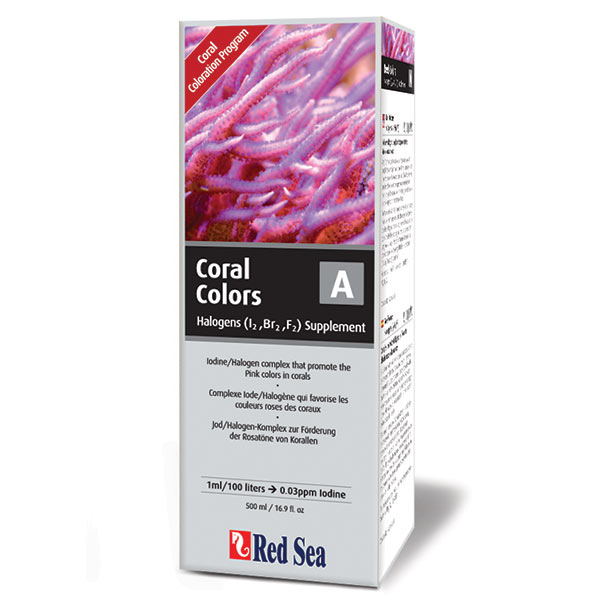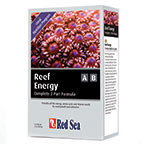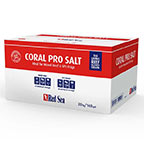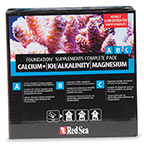
Additional sizes may be available!
Additional sizes may be available! Email me when availableOverview
| * | Reef aquarium supplement containing iodine and other halogens |
| * | Iodine/Halogen complex encourages enhanced coral coloration |
| * | Correct concentration promotes pink coloration in aquarium corals |
Promote natural pink coloration in corals for vibrant reef displays. Red Sea Coral Colors A Reef Supplement is a special color-enhancing blend of iodine, bromine, and fluorine that helps bring out pink color pigments in the soft tissue of stony corals. Unlike conventional iodine supplements, this unique iodine/halogen complex contains the correct concentrations necessary for corals to display their natural colors.
Red Sea Coral Colors A Reef Supplement is part of Red Sea's Coral Coloration Program designed to accurately replenish the 31 minor and trace elements, present in the skeleton and soft tissue of all corals, which enable corals to display their natural colors. Coral Colors A Supplement contains iodine and other halogens associated with many biological processes.
Iodine is related to the pink chromo-protein (pocciloporin). Proper iodine supplementation encourages enhanced coral coloration for a stunning and vibrantly-colored reef aquarium. The halogens also act both as antioxidants and oxidative agents within the soft tissue and mucus layer of corals to help reduce the possibility of coral bleaching.
Concentration:
1ml will raise the iodine level of 100 liters (25 gal) by 0.03ppm.
Use Red Sea Iodine Pro Test Kit for accurate testing crucial when supplementing corals with iodine.
For best results in displaying coral colors use Red Sea NO3:PO4-X Biological Nitrate and Phosphate Reducer.
Please note: Iodine becomes toxic in concentrations above the levels found in natural seawater. Therefore, correct dosage of iodine supplements and routine iodine testing is crucial to the health and success of any reef aquarium.
General Instructions for Testing and Supplementing
- Before carrying out any water testing, always check the salinity and make adjustments as necessary. If you have made adjustments to the water, wait 10 minutes for the water parameters to stabilize (e.g. 1ppt increase in salinity due to evaporation of fresh water will result in an approximate increase of 13ppm Ca).
- Test only with high accuracy test kits such as the Red Sea Pro Kits.
- All of the Red Sea Reef Care Program supplements have dosing charts (on back of product) based on treating 100 liters / 25 gallons of water. Estimate your total volume of water (aquarium & sump less volume of live rocks etc) to calculate the correct dosage for your system.
- Supplements should be added to the sump. If you do not have a sump, add the supplements slowly to an area with high water flow to prevent direct contact with the corals.
- To prevent stress to the corals the maximum daily increases of each of the elements are as follows: Iodine 0.03ppm; Potassium 10ppm; Iron 0.05ppm. Larger adjustments should be spread over a few days according to the daily maximum.
Testing and Supplementing
Test either Calcium or the Color Elements every week.
SPS corals have a relatively high uptake of calcium and therefore of all the Coral Color elements. Since the stability of the water parameters is essential for their health and vitality, supplementing of the Color Elements should be done daily. At lower nutrient levels for enhanced coral coloration, it is preferable to test the individual color elements.
LPS corals have a lower uptake of calcium and therefore, they can tolerate the Color Elements being supplemented weekly. They will however benefit from a daily supplementing regime. Choose which of these supplementing options is best for you and your aquarium.
Soft corals only need Colors A & B and should be supplemented weekly. To promote coralline algae in a soft coral aquarium use Coral Color C.
Dosing by Total Elemental Demand
Coral Colors A, B & C each contain a leading element (Iodine, Potassium & Iron) that is accurately measurable with Red Sea's unique Coral Colors Pro test kits enabling the replenishment of each of these supplements according to the total demand of the reef.
When first using the Coral Colors products or after a water-change, test the levels of the Color Elements and supplement as necessary to achieve the optimal levels.
Dosing by Calcium (Coral Growth) Demand
Red Sea's research also identified a constant ratio between each of the Coral Colors and the overall consumption of calcium, which is proportional to coral growth and metabolic activity. Therefore, by measuring the uptake of calcium by the corals, we are able to replenish all of the elements that have definitely been depleted from the water by the corals, without the danger of reaching toxic levels. This method of dosing should be used for supplementing Coral Color D and can be applied successfully to Coral Colors A, B, & C.
Calculate the daily or weekly dose of each supplement according to the dosage of Red Sea's Reef Foundation supplements or to a known uptake of calcium. (Add 1ml of Color supplement for every 20ppm of Calcium added per 100 liters (25 gal) of aquarium water or for every 2g of calcium uptake.)
Weekly dosing - Soft Corals
Test the Color Elements every week and dose each supplement to replenish back to the optimal levels.
Daily dosing - SPS corals
Ensure that all of the Color Elements are at optimal values and run the aquarium for 4 days at a stable salinity (compensate for evaporation daily) without adding any supplements. At the end of the 4 days test the Color Elements and calculate the "4 day dosage" of each supplement to replenish back to the optimal levels. Add the "4 day dosage" to the system. Divide this "4 day dosage" by 4 and use as the daily dosage for the next week.
After a week of adding the daily dosage, test the Color Elements and calculate the adjusting dosage of each supplement to replenish back to the optimal levels.
- If the adjusting dosage is significantly different from the previous daily dosage, amend (increase/decrease) the daily dosage as appropriate.
- If the measured level of a specific element is above the optimal level, wait for the excess of the element to be depleted before restarting the daily supplementation with the amended daily dosage.
Continue testing all of the elements every week and make adjustments to the daily dosages as required. As your corals grow or you add or remove livestock the uptake of the elements in your aquarium will gradually change. It is recommended to keep a log book of the weekly measurements and dosages.
If you miss one or more days of supplementing, add the complete amount that you have missed but do not exceed the maximum recommended daily increase for any of the elements.
| Red Sea Coral Color A Reef Supplement | |
| Coral Color A | Complex of halogen elements |
| Main elements | Iodine, Bromine and Fluorine |
| Test for dosing | Iodine |
| Function | The halogens act both as antioxidants and oxidative agents within the soft tissue and mucus layer of corals, reducing the possibilities for coral bleaching. In active reef systems these elements are depleted very quickly due to their high oxidative abilities and reactivity with organic materials. |
| Coloration | Iodine and bromine are related to the pink chromo-protein (pociloporin) |
| Level in NSW
(Natural Sea Water) |
Iodine 0.06 ppm; Bromine 65 ppm; Fluorine 1.3 ppm |
| Overdose | Halogens can have adverse effects on the soft tissues of corals and all micro-fauna. Common indication of overdose is a severe regression of the soft tissues of hard corals and pale colors in soft corals. In case of over dosing, change 50% of the water and reduce the supplementing dosage by 50%. |
Coral Color A
Iodine/Halogen complex that promote the pink colors in corals
I2 | Br2 | F2
Coral Colors A Supplement is part of the complete range of complementary major, minor and trace element complexes, which together provide the needs of corals.
Coral Colors A Supplement contains iodine and other halogens that are associated with many biological processes, one of them being the production of the pink pigments in the soft tissue of corals.
The halogens act both as antioxidants and oxidative agents within the soft tissue and mucus layer of corals, reducing the possibility of coral bleaching.
In active reef systems, these elements are depleted quickly due to their high oxidative abilities and reactivity with organic materials. Iodine and bromine are related to the pink chromo-protein (pocciloporin).
Concentration:
1ml will raise the iodine level of 100 liters (25 gal) by 0.03ppm
General Information
Red Sea Coral Coloration Program
Coral Colors
Red Sea's research into the metabolic demand of 3 different coral types (SPS, LPS, soft corals) has identified 31 minor and trace elements that in addition to the foundation elements are present in the skeleton and soft tissue of all corals. These elements are known as important bio-catalysts in thousands of metabolic processes in marine organisms and therefore must be readily available in all reef aquariums. Many of them, however, become toxic in concentrations above the levels found in natural seawater and therefore, their correct dosage is crucial to the long term success of any reef aquarium.
Enhanced Coloration
In reef aquariums, corals often have higher than natural populations of Zooxanthellae algae that give a deep brown tint obscuring the natural vivid pigments of the corals. Lowering the Zooxanthellae populations by fine control of algae nutrients (with NO3:PO4-X) will remove the brownish tint and induce the production of pigments (chromoproteins) that protect the delicate inner layers of the coral soft tissue from intense UV radiation, similar to the tanning of human skin when exposed to direct sunlight.
Red Sea's research has shown that the pigments can only be produced by the soft tissue of the coral if the specific elements required for the bio-chemical process are available in the correct concentration. Each of the natural pink, red, green/yellow & blue/purple pigments are connected with specific elements that correlate with the elemental grouping of the Coral Colors A, B, C & D.









